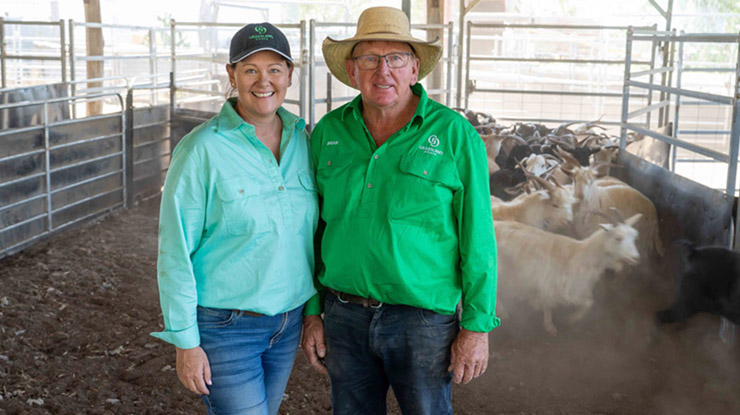 Keeleigh and Brian Allport have been building up their goatmeat brand, Grassland Goats, since 2021.
Keeleigh and Brian Allport have been building up their goatmeat brand, Grassland Goats, since 2021.
Grassland Goats: Grow your goatmeat business by understanding what customers want
When Keeleigh and Brian Allport first introduced goats onto their property for vegetation management in 2018, they weren't planning on building a branded goatmeat business.
What started as a drought-management strategy evolved into Grassland Goats – the Allports’ thriving, vertically integrated business delivering an average of 500–600 goats per week to butchers and meat wholesalers in south-east Queensland.
As their enterprise grew, Keeleigh and Brian maintained focus on their target market with customer trends, feedback and education informing their pre- and post- farm-gate business strategies.
The path to market
Originally based at Moonie in Queensland’s Western Downs region, the 2018–19 drought saw Keeleigh and Brian destock most of their cattle and look for new market opportunities. They canvassed meat buyers and wholesalers across south-east Queensland while working with a local abattoir to get a foothold in a small but growing domestic goatmeat market.
Grassland Goats launched in April 2021, supplying 30 live animals each week to a wholesale buyer in Brisbane. However, COVID-19 limited access to abattoirs and suppressed demand, so the Allports explored opportunities to integrate processing and distribution into their own operation.
Goats are now bred and managed on their Gore property in southern Queensland and are sold direct to market. Keeleigh and Brian work with a secondary processing contractor (supported by some of their staff for packing and fulfillment) and use their own livestock and cold trucks from the property, which has convenient access to freight routes and markets across Australia’s eastern states.
“In terms of our return on investment, we have better control and visibility of our supply chain. This means we’re now price makers, not price takers,” said Keeleigh.
Genetics and nutrition for a high-quality product
Keeleigh and Brian’s on-farm genetics and nutrition program ensures they can deliver a consistent, high-quality product throughout the year.
The couple runs a crossbred herd, joining purebred Boer and Kalahari bucks with high-quality genetics to their rangeland-based herd. They manage a continuous joining, breeding and weaning program, focusing on traits for reproduction, climatic adaptability and carcase quality.
Goats co-graze with sheep and cattle across their 23,000-acre property, dominated by native grasses. The herd is also supplemented with a grain ration to maintain consistent production.
“Our point of difference is that we can supply premium quality goatmeat, week in, week out,” Keeleigh said.
“When we first introduced meat breeds to our rangeland herd, we were surprised to find that consumers weren’t used to the quality – there was a misconception that heavier carcases were from older animals.
“Over time, through education, our customers have come to value the premium quality and tenderness of the product, which we’re incredibly proud of.
“As product quality goes up, demand goes up.”
Meeting market specifications
For Keeleigh and Brian, success comes from their ability to supply the right product for their target market, which is largely represented by populations with African, Asian and Middle Eastern backgrounds who use goat as a staple protein.
“Consumers in this category are generally price sensitive and cook with whole carcases. Peak demand also coincides with cultural celebrations.
“We’re 100% focused on supplying a product for our target market – blemish free, and 12–18kg in carcase weight,” Keeleigh said.
“We use the whole carcase, focusing on the cuts and value-add products that return the best value to the business. We have nose-to-tail production opportunities working with retail, butcher and pet food customers.
“We do also supply diced goatmeat which mostly goes to southern markets and is in demand due to labour shortages of specialist butchers to cut up the meat. We also have demand for our offal.
“We’ve tried other primal cuts but just found it wasn’t worthwhile. Goat primals are harder to cook with and require different cooking methods than traditional protein such as lamb. Goat is generally cooked low and slow, bone in,” she said.
“If our product isn’t what our customers want, they give us feedback.”
Using data to automate processes
Customer assurance is an important part of the Grassland Goats business. With significant data and information generated across their supply chain, Keeleigh is looking forward to automating their processes.
“Now we’ve got the customer requirements and production side right, we can focus on the other aspects of the business.
“A lot of our data management has been done manually. We’ve got some great spreadsheets but we’re in the process of automating our systems and processes – which means we’ll be able to automate customer ordering, order fulfillment, invoicing and traceability.
“That will give us better oversight, and insights, across the supply chain – including farm production, processing and logistics.”



